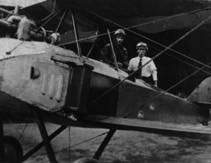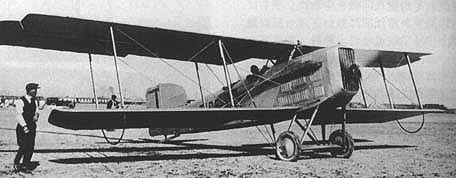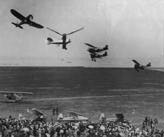The Wright brothers made the first motorized flight in 1903. Seven years later, the first flight in Japan was made by Captain Tokugawa, flying a Farman airplane at Yoyogi Army Field. In 1911, the first Japanese engineered and manufactured airplane "Kai-shiki (Type Kai) No.1" made the first flight successfully at Tokorozawa Airfield (currently Tokorozawa Air Memorial Park).
In 1917, Chikuhei Nakajima (33 years old at that time), who retired as Engineering Captain of the Navy, contemplating developing a public aircraft industry, set up the "Airplane Institute" at Ojima Town close to Ota Town in Gunma Prefecture (currently Ota City). The building was a simply remodeled sericultural hut along the Tone River. In the beginning, there were only nine members, but in the following year they built their first airplane; the first "Nakajima Type 1" with a U.S.A. made engine. But the first Type 1 sadly crashed after take off. The second Type 1 also failed, and the third one finally did take off, but hit a ditch upon landing and also crashed. In that age, it was said that there was a pasquinade in Ota Town, "Too much paper money, too high a price for rice. Everything goes up, except Nakajima planes".
After the trials and tribulations in the foundation period, the sixth Nakajima Type 4 was finally completed, and flew over Ojima Town proudly.In 1919, the first mail plane contest was held between Tokyo and Osaka. Nakajima Type 4 cleared the distance in 3 hours and 18 minutes, and defeated the imported planes. Together with the prize money of 9,500 yen, it provided a good opportunity to demonstrate their engineering superiority to the public. The person who instructed this project both in engineering and management was Jingo Kuribara. He was not a flashy person but rather shy. A born engineer, he studied hard and his intellect captured the era. Kuribara at that time was General Manager of the Donryu Factory, and also General Manager of the Ota Factory. He played a leading role in developing later Nakajima Aircraft. In the management of the Institute, Kuribara exerted his energy to find the most competent people.
--
Left: "Airplane Institute" 1918, (currently Ota City)
Right: Nakajima debut products, the Sixth Type 4, 1919In 1920, the military having noticed drastic progress in aircraft technology during World War I in Europe, invited a training team from France and also started to seriously study licensed production of airplane bodies and engines. Nakajima Aircraft dispatched Kimihei Nakajima to France for a long period in order for him gather information and technologies regarding airplanes. With this as a turning point, Nakajima Aircraft received a large order from the military, and tremendous growth followed.
In 1922, the first all-metal airplane, Nakajima Type B-6 was completed. It was modeled after the Breguet 14. The Type B-6 and named "Kei-Gin Go (light silver)" since the revolutionary light weight metal at that time, duralumin, was used. It was revealed at the "Peace Memorial Tokyo Exposition" and got high reviews. (The picture below shows the B-6. The engine was a Rolls Royce water cooled V12, 360PS)
In 1922, Ichiro Sakuma was looking in the suburbs of Tokyo for the site of an exclusive airplane engine factory, and found one at Kamiigusa, Iogi, Toyotama-Gun (Ogikubo). He bought an area of
12,540m2 the next year. Construction started immediately, and the Tokyo Factory was finished in 1924 and began to license and manufacture water-cooled Laurence engines. Separate working environments (engine production in Tokyo and body production in Ota) were established at that time.
From the Taisho Era to the Showa Era there was substantial progress in engineering due to the introduction of foreign technologies. In 1927, a competition was ordered by the Army to create the next generation fighter plane. Mitsubishi Internal Combustion Engine Co., Kawasaki Ship Building Co., Ishikawajima Aircraft Co. and Nakajima Aircraft Industries all participated. In 1928, Nakajima produced an airplane with a single high-wing with struts, named Type NC. In comparison with Mitsubishi and Kawasaki, which applied German style, water cooled, straight-line-based rugged designs, Nakajima Type NC had a streamlined and slender body with an air cooled engine. It resembled the Nieuport Delage in France, and at a glance, seemed nimble and agile. All Nakajima planes were designed with flowing elegance as tradition, and it was said that there was a common understanding among the engineers that "Real things (airplanes) reaching the pinnacle of engineering excellence should be beautiful" (The picture below shows Type NC N0.7)
The engine of the Type NC airplane was changed with a Nakajima Jupiter 7 type, a Taunend type cowling was attached, and the entire body was refined with great effort. The plane was then adopted by the Army as the Type 91 fighter.
At that time, the Navy was studying 1928 Boeing 69B fighters and 1933 Boeing 100D fighters, but Nakajima was developing an original fighter named NY Navy Fighter independently to surpass those imported planes. The N of NY stood for Nakajima and Y was for the name of the chief engineer, Takao Yoshida. The airplane being developed was utilizing the Jupiter 7 of English Bristol Bulldog family, and was called the "Yoshida Bulldog" but was not adopted by the Army. Nakajima then replaced the chief engineer with Jingo Kuribara, and changed the engine to a newly developed Nakajima "Kotobuki (auspicious)", and the "NY-Kai (NY-II)" was completed in 1932. The marked improvement in its performance was acknowledged and it was adopted as the Type 90 carrier fighter. At the dedication and naming ceremony in Haneda, the name "Hokoku (patriotic spirit)" was given, and together with other planes from Yokosuka Airforce, it demonstrated formation aerobatics. Among them, famous aerobatics performances made by the master trio of Genda, Okamura and Nomura were given, and they later became to be known as the "Genda Circus". From here on, Nakajima quickly rose to fame and later monopolized of the production of Army and Navy fighter planes.Type 90 type 2 Carrier Fighter
----
Nakajima P-1 Mail Plane Air Pageant held at Haneda, 1937



